Comprehensive Business and Business Environment Analysis: M&S Report
VerifiedAdded on 2020/10/23
|13
|4161
|479
Report
AI Summary
This report provides a comprehensive analysis of the business environment, focusing on Marks & Spencer (M&S). It begins with an introduction to the business environment, defining its internal and external factors. The report then examines different types of organizations, including profit-based, non-profit, and NGOs, and classifies them by size (small, medium, large) and ownership (sole trader, partnership, private limited companies). The report then delves into the size, scope, and purpose of M&S, NHS, and Oxfam. It further explores the interrelation between various organizational functions within M&S, such as marketing, production, finance, and HR, and how they contribute to the company's objectives. The report also identifies the positive and negative impacts of the macro environment on M&S using PESTEL analysis, examining political, economic, social, technological, environmental, and legal factors. Finally, it conducts internal and external analyses using SWOT analysis, highlighting the company's strengths, weaknesses, opportunities, and threats. The report concludes by summarizing the key findings and their implications for M&S's operations and strategic planning.
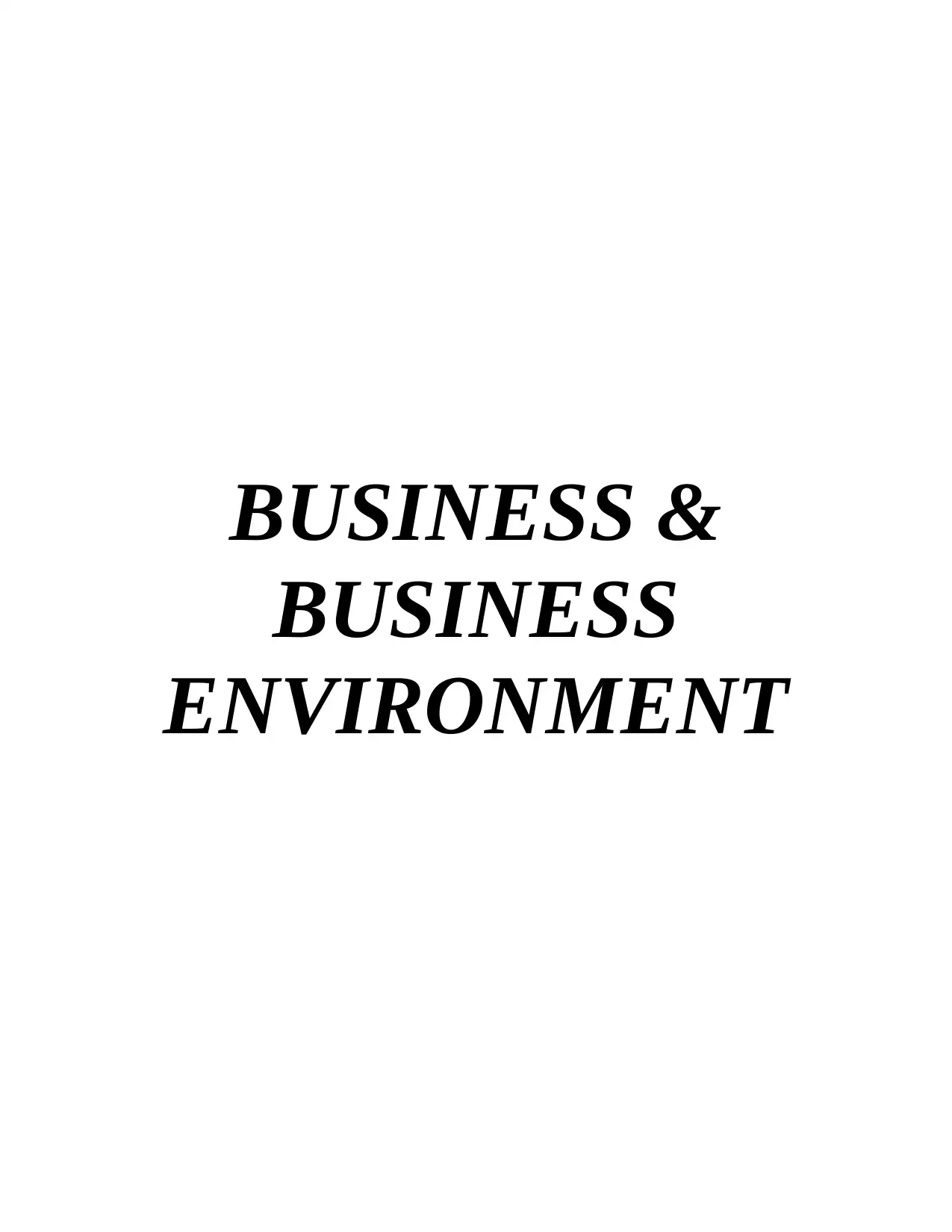
BUSINESS &
BUSINESS
ENVIRONMENT
BUSINESS
ENVIRONMENT
Paraphrase This Document
Need a fresh take? Get an instant paraphrase of this document with our AI Paraphraser
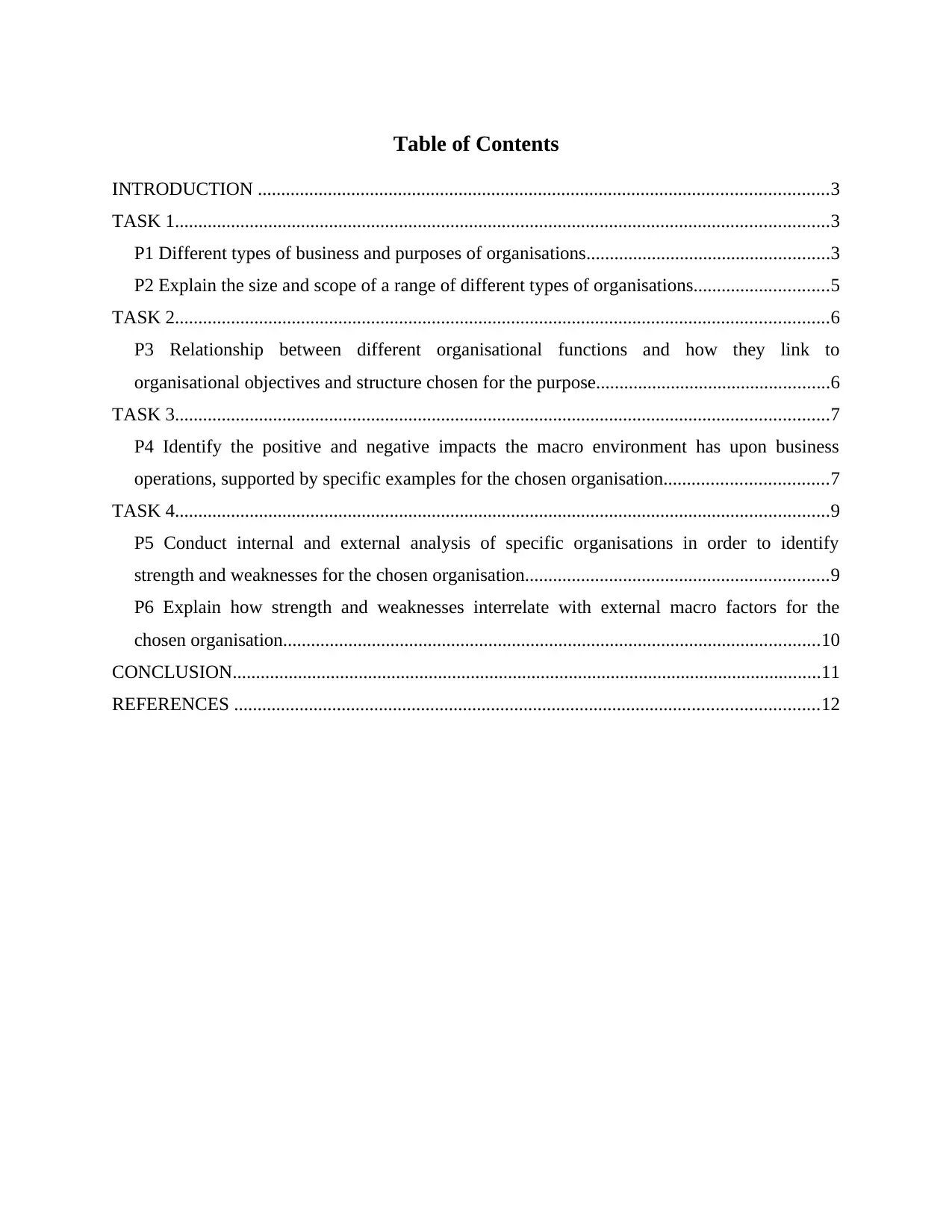
Table of Contents
INTRODUCTION ..........................................................................................................................3
TASK 1............................................................................................................................................3
P1 Different types of business and purposes of organisations....................................................3
P2 Explain the size and scope of a range of different types of organisations.............................5
TASK 2............................................................................................................................................6
P3 Relationship between different organisational functions and how they link to
organisational objectives and structure chosen for the purpose..................................................6
TASK 3............................................................................................................................................7
P4 Identify the positive and negative impacts the macro environment has upon business
operations, supported by specific examples for the chosen organisation...................................7
TASK 4............................................................................................................................................9
P5 Conduct internal and external analysis of specific organisations in order to identify
strength and weaknesses for the chosen organisation.................................................................9
P6 Explain how strength and weaknesses interrelate with external macro factors for the
chosen organisation...................................................................................................................10
CONCLUSION..............................................................................................................................11
REFERENCES .............................................................................................................................12
INTRODUCTION ..........................................................................................................................3
TASK 1............................................................................................................................................3
P1 Different types of business and purposes of organisations....................................................3
P2 Explain the size and scope of a range of different types of organisations.............................5
TASK 2............................................................................................................................................6
P3 Relationship between different organisational functions and how they link to
organisational objectives and structure chosen for the purpose..................................................6
TASK 3............................................................................................................................................7
P4 Identify the positive and negative impacts the macro environment has upon business
operations, supported by specific examples for the chosen organisation...................................7
TASK 4............................................................................................................................................9
P5 Conduct internal and external analysis of specific organisations in order to identify
strength and weaknesses for the chosen organisation.................................................................9
P6 Explain how strength and weaknesses interrelate with external macro factors for the
chosen organisation...................................................................................................................10
CONCLUSION..............................................................................................................................11
REFERENCES .............................................................................................................................12
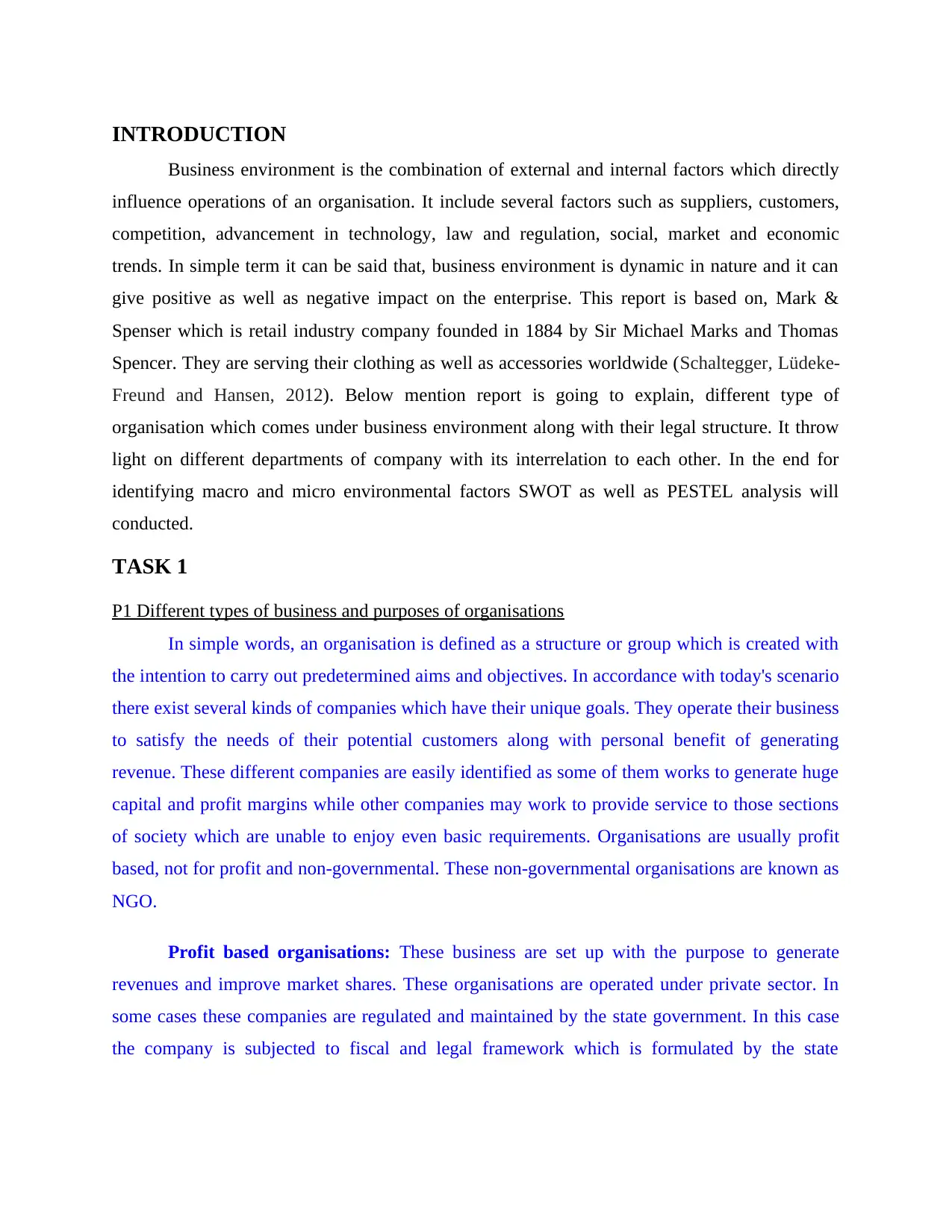
INTRODUCTION
Business environment is the combination of external and internal factors which directly
influence operations of an organisation. It include several factors such as suppliers, customers,
competition, advancement in technology, law and regulation, social, market and economic
trends. In simple term it can be said that, business environment is dynamic in nature and it can
give positive as well as negative impact on the enterprise. This report is based on, Mark &
Spenser which is retail industry company founded in 1884 by Sir Michael Marks and Thomas
Spencer. They are serving their clothing as well as accessories worldwide (Schaltegger, Lüdeke-
Freund and Hansen, 2012). Below mention report is going to explain, different type of
organisation which comes under business environment along with their legal structure. It throw
light on different departments of company with its interrelation to each other. In the end for
identifying macro and micro environmental factors SWOT as well as PESTEL analysis will
conducted.
TASK 1
P1 Different types of business and purposes of organisations
In simple words, an organisation is defined as a structure or group which is created with
the intention to carry out predetermined aims and objectives. In accordance with today's scenario
there exist several kinds of companies which have their unique goals. They operate their business
to satisfy the needs of their potential customers along with personal benefit of generating
revenue. These different companies are easily identified as some of them works to generate huge
capital and profit margins while other companies may work to provide service to those sections
of society which are unable to enjoy even basic requirements. Organisations are usually profit
based, not for profit and non-governmental. These non-governmental organisations are known as
NGO.
Profit based organisations: These business are set up with the purpose to generate
revenues and improve market shares. These organisations are operated under private sector. In
some cases these companies are regulated and maintained by the state government. In this case
the company is subjected to fiscal and legal framework which is formulated by the state
Business environment is the combination of external and internal factors which directly
influence operations of an organisation. It include several factors such as suppliers, customers,
competition, advancement in technology, law and regulation, social, market and economic
trends. In simple term it can be said that, business environment is dynamic in nature and it can
give positive as well as negative impact on the enterprise. This report is based on, Mark &
Spenser which is retail industry company founded in 1884 by Sir Michael Marks and Thomas
Spencer. They are serving their clothing as well as accessories worldwide (Schaltegger, Lüdeke-
Freund and Hansen, 2012). Below mention report is going to explain, different type of
organisation which comes under business environment along with their legal structure. It throw
light on different departments of company with its interrelation to each other. In the end for
identifying macro and micro environmental factors SWOT as well as PESTEL analysis will
conducted.
TASK 1
P1 Different types of business and purposes of organisations
In simple words, an organisation is defined as a structure or group which is created with
the intention to carry out predetermined aims and objectives. In accordance with today's scenario
there exist several kinds of companies which have their unique goals. They operate their business
to satisfy the needs of their potential customers along with personal benefit of generating
revenue. These different companies are easily identified as some of them works to generate huge
capital and profit margins while other companies may work to provide service to those sections
of society which are unable to enjoy even basic requirements. Organisations are usually profit
based, not for profit and non-governmental. These non-governmental organisations are known as
NGO.
Profit based organisations: These business are set up with the purpose to generate
revenues and improve market shares. These organisations are operated under private sector. In
some cases these companies are regulated and maintained by the state government. In this case
the company is subjected to fiscal and legal framework which is formulated by the state
⊘ This is a preview!⊘
Do you want full access?
Subscribe today to unlock all pages.

Trusted by 1+ million students worldwide
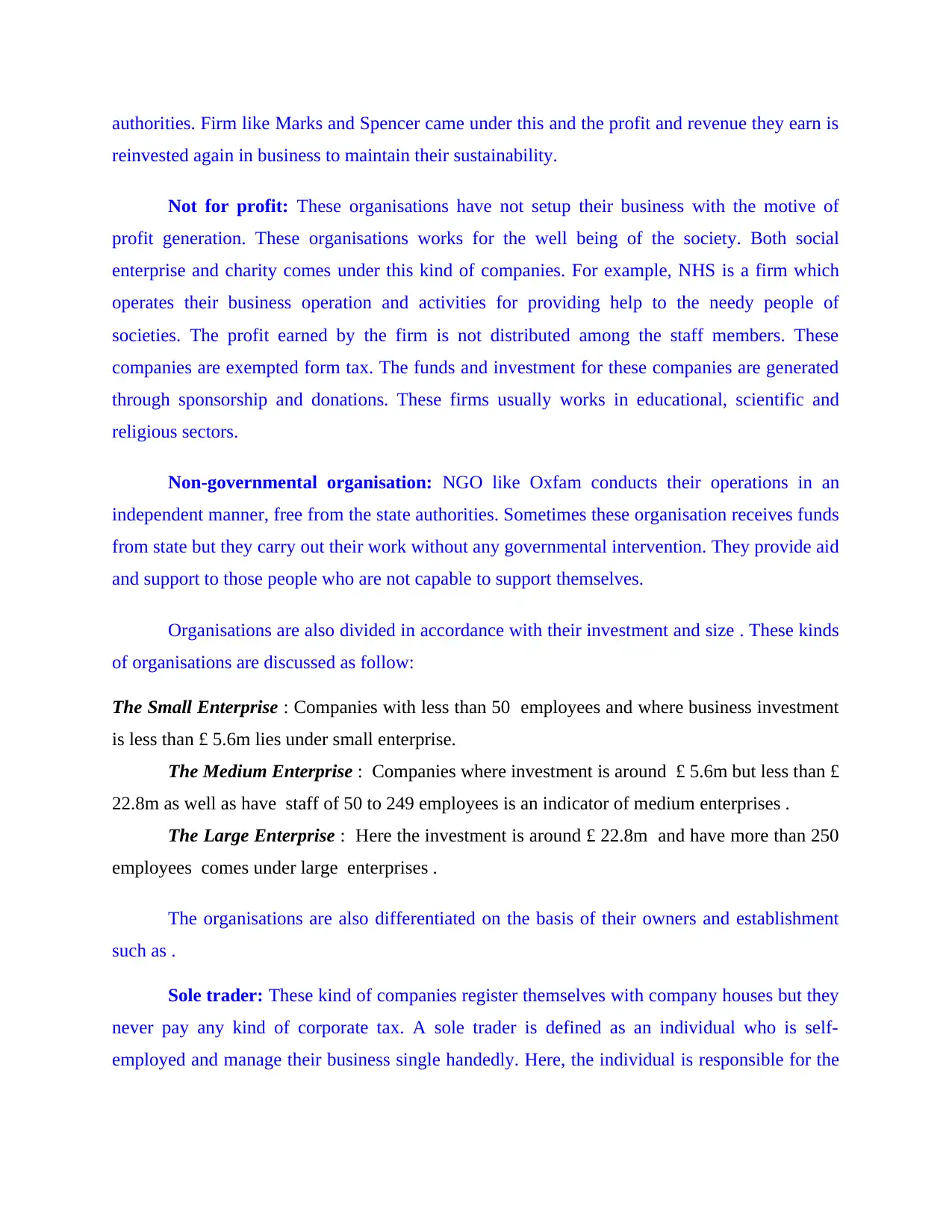
authorities. Firm like Marks and Spencer came under this and the profit and revenue they earn is
reinvested again in business to maintain their sustainability.
Not for profit: These organisations have not setup their business with the motive of
profit generation. These organisations works for the well being of the society. Both social
enterprise and charity comes under this kind of companies. For example, NHS is a firm which
operates their business operation and activities for providing help to the needy people of
societies. The profit earned by the firm is not distributed among the staff members. These
companies are exempted form tax. The funds and investment for these companies are generated
through sponsorship and donations. These firms usually works in educational, scientific and
religious sectors.
Non-governmental organisation: NGO like Oxfam conducts their operations in an
independent manner, free from the state authorities. Sometimes these organisation receives funds
from state but they carry out their work without any governmental intervention. They provide aid
and support to those people who are not capable to support themselves.
Organisations are also divided in accordance with their investment and size . These kinds
of organisations are discussed as follow:
The Small Enterprise : Companies with less than 50 employees and where business investment
is less than £ 5.6m lies under small enterprise.
The Medium Enterprise : Companies where investment is around £ 5.6m but less than £
22.8m as well as have staff of 50 to 249 employees is an indicator of medium enterprises .
The Large Enterprise : Here the investment is around £ 22.8m and have more than 250
employees comes under large enterprises .
The organisations are also differentiated on the basis of their owners and establishment
such as .
Sole trader: These kind of companies register themselves with company houses but they
never pay any kind of corporate tax. A sole trader is defined as an individual who is self-
employed and manage their business single handedly. Here, the individual is responsible for the
reinvested again in business to maintain their sustainability.
Not for profit: These organisations have not setup their business with the motive of
profit generation. These organisations works for the well being of the society. Both social
enterprise and charity comes under this kind of companies. For example, NHS is a firm which
operates their business operation and activities for providing help to the needy people of
societies. The profit earned by the firm is not distributed among the staff members. These
companies are exempted form tax. The funds and investment for these companies are generated
through sponsorship and donations. These firms usually works in educational, scientific and
religious sectors.
Non-governmental organisation: NGO like Oxfam conducts their operations in an
independent manner, free from the state authorities. Sometimes these organisation receives funds
from state but they carry out their work without any governmental intervention. They provide aid
and support to those people who are not capable to support themselves.
Organisations are also divided in accordance with their investment and size . These kinds
of organisations are discussed as follow:
The Small Enterprise : Companies with less than 50 employees and where business investment
is less than £ 5.6m lies under small enterprise.
The Medium Enterprise : Companies where investment is around £ 5.6m but less than £
22.8m as well as have staff of 50 to 249 employees is an indicator of medium enterprises .
The Large Enterprise : Here the investment is around £ 22.8m and have more than 250
employees comes under large enterprises .
The organisations are also differentiated on the basis of their owners and establishment
such as .
Sole trader: These kind of companies register themselves with company houses but they
never pay any kind of corporate tax. A sole trader is defined as an individual who is self-
employed and manage their business single handedly. Here, the individual is responsible for the
Paraphrase This Document
Need a fresh take? Get an instant paraphrase of this document with our AI Paraphraser

profits and loss that a business faces while carrying out their business operations. All the debts
and losses are faced by business owner only.
Partnership: In these kinds of business usually two or more than two people are
responsible for the business operations. All the revenue and profit margins are divided equally
among all partners. They manage their tax and other legal aspects on their own.
Private limited companies: These organisations are set up in a way where finances of
company kept separate from personal finances. Shareholders divide the profits as dividends.
These are of further two types which is P.L.C where share are manage through stock exchange.
Another id l.t.d. Where shares cant be purchased through stock exchange.
P2 Explain the size and scope of a range of different types of organisations
Every organisations are different in size and their business purpose and can be explained
as following:
Size, scope and purpose of Marks and Spencer:
Size of M&S: This company under profit organisations have approximately eighty five
thousand employees and have their more thousand stores in UK and many other outlets
worldwide.
Scope of M&S: The company have large scope to establish itself as a market leader in
retail business continuity by embedding a group wide business continuity management culture.
Purpose of M&S: Marks and Spencer deals with a purpose to earn maximum profit and
to become market leader in retail business as well as to serve best quality or products and
services to their customers.
Size, scope and purpose of NHS:
Size of NHS: National Health and Services serves global health care and services having
around 1680 NHS hospitals and have approx 1.4 million of employees or members in it.
Scope of NHS: The organisation have futuristic mindset to provide comprehensive range
of health care services to fulfil needs and preferences of individual patients, their families and
carers (Werbach and Hunter, 2012).
Purpose of NHS: Being a non-profitable industry NHS do not want to earn for
profitability and use their revenues in serving more efficiently in health and care sector.
Size, scope and purpose of Oxfam:
and losses are faced by business owner only.
Partnership: In these kinds of business usually two or more than two people are
responsible for the business operations. All the revenue and profit margins are divided equally
among all partners. They manage their tax and other legal aspects on their own.
Private limited companies: These organisations are set up in a way where finances of
company kept separate from personal finances. Shareholders divide the profits as dividends.
These are of further two types which is P.L.C where share are manage through stock exchange.
Another id l.t.d. Where shares cant be purchased through stock exchange.
P2 Explain the size and scope of a range of different types of organisations
Every organisations are different in size and their business purpose and can be explained
as following:
Size, scope and purpose of Marks and Spencer:
Size of M&S: This company under profit organisations have approximately eighty five
thousand employees and have their more thousand stores in UK and many other outlets
worldwide.
Scope of M&S: The company have large scope to establish itself as a market leader in
retail business continuity by embedding a group wide business continuity management culture.
Purpose of M&S: Marks and Spencer deals with a purpose to earn maximum profit and
to become market leader in retail business as well as to serve best quality or products and
services to their customers.
Size, scope and purpose of NHS:
Size of NHS: National Health and Services serves global health care and services having
around 1680 NHS hospitals and have approx 1.4 million of employees or members in it.
Scope of NHS: The organisation have futuristic mindset to provide comprehensive range
of health care services to fulfil needs and preferences of individual patients, their families and
carers (Werbach and Hunter, 2012).
Purpose of NHS: Being a non-profitable industry NHS do not want to earn for
profitability and use their revenues in serving more efficiently in health and care sector.
Size, scope and purpose of Oxfam:
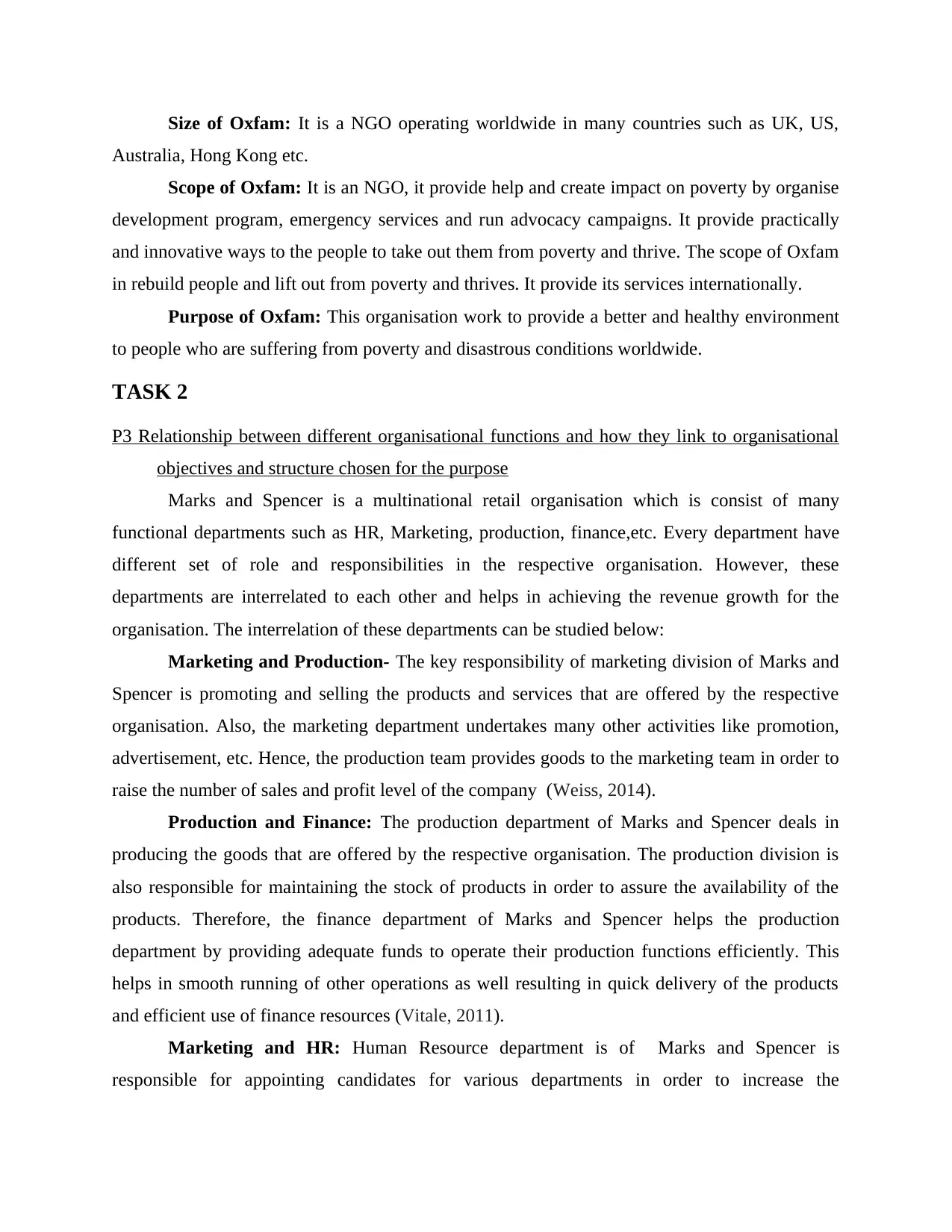
Size of Oxfam: It is a NGO operating worldwide in many countries such as UK, US,
Australia, Hong Kong etc.
Scope of Oxfam: It is an NGO, it provide help and create impact on poverty by organise
development program, emergency services and run advocacy campaigns. It provide practically
and innovative ways to the people to take out them from poverty and thrive. The scope of Oxfam
in rebuild people and lift out from poverty and thrives. It provide its services internationally.
Purpose of Oxfam: This organisation work to provide a better and healthy environment
to people who are suffering from poverty and disastrous conditions worldwide.
TASK 2
P3 Relationship between different organisational functions and how they link to organisational
objectives and structure chosen for the purpose
Marks and Spencer is a multinational retail organisation which is consist of many
functional departments such as HR, Marketing, production, finance,etc. Every department have
different set of role and responsibilities in the respective organisation. However, these
departments are interrelated to each other and helps in achieving the revenue growth for the
organisation. The interrelation of these departments can be studied below:
Marketing and Production- The key responsibility of marketing division of Marks and
Spencer is promoting and selling the products and services that are offered by the respective
organisation. Also, the marketing department undertakes many other activities like promotion,
advertisement, etc. Hence, the production team provides goods to the marketing team in order to
raise the number of sales and profit level of the company (Weiss, 2014).
Production and Finance: The production department of Marks and Spencer deals in
producing the goods that are offered by the respective organisation. The production division is
also responsible for maintaining the stock of products in order to assure the availability of the
products. Therefore, the finance department of Marks and Spencer helps the production
department by providing adequate funds to operate their production functions efficiently. This
helps in smooth running of other operations as well resulting in quick delivery of the products
and efficient use of finance resources (Vitale, 2011).
Marketing and HR: Human Resource department is of Marks and Spencer is
responsible for appointing candidates for various departments in order to increase the
Australia, Hong Kong etc.
Scope of Oxfam: It is an NGO, it provide help and create impact on poverty by organise
development program, emergency services and run advocacy campaigns. It provide practically
and innovative ways to the people to take out them from poverty and thrive. The scope of Oxfam
in rebuild people and lift out from poverty and thrives. It provide its services internationally.
Purpose of Oxfam: This organisation work to provide a better and healthy environment
to people who are suffering from poverty and disastrous conditions worldwide.
TASK 2
P3 Relationship between different organisational functions and how they link to organisational
objectives and structure chosen for the purpose
Marks and Spencer is a multinational retail organisation which is consist of many
functional departments such as HR, Marketing, production, finance,etc. Every department have
different set of role and responsibilities in the respective organisation. However, these
departments are interrelated to each other and helps in achieving the revenue growth for the
organisation. The interrelation of these departments can be studied below:
Marketing and Production- The key responsibility of marketing division of Marks and
Spencer is promoting and selling the products and services that are offered by the respective
organisation. Also, the marketing department undertakes many other activities like promotion,
advertisement, etc. Hence, the production team provides goods to the marketing team in order to
raise the number of sales and profit level of the company (Weiss, 2014).
Production and Finance: The production department of Marks and Spencer deals in
producing the goods that are offered by the respective organisation. The production division is
also responsible for maintaining the stock of products in order to assure the availability of the
products. Therefore, the finance department of Marks and Spencer helps the production
department by providing adequate funds to operate their production functions efficiently. This
helps in smooth running of other operations as well resulting in quick delivery of the products
and efficient use of finance resources (Vitale, 2011).
Marketing and HR: Human Resource department is of Marks and Spencer is
responsible for appointing candidates for various departments in order to increase the
⊘ This is a preview!⊘
Do you want full access?
Subscribe today to unlock all pages.

Trusted by 1+ million students worldwide
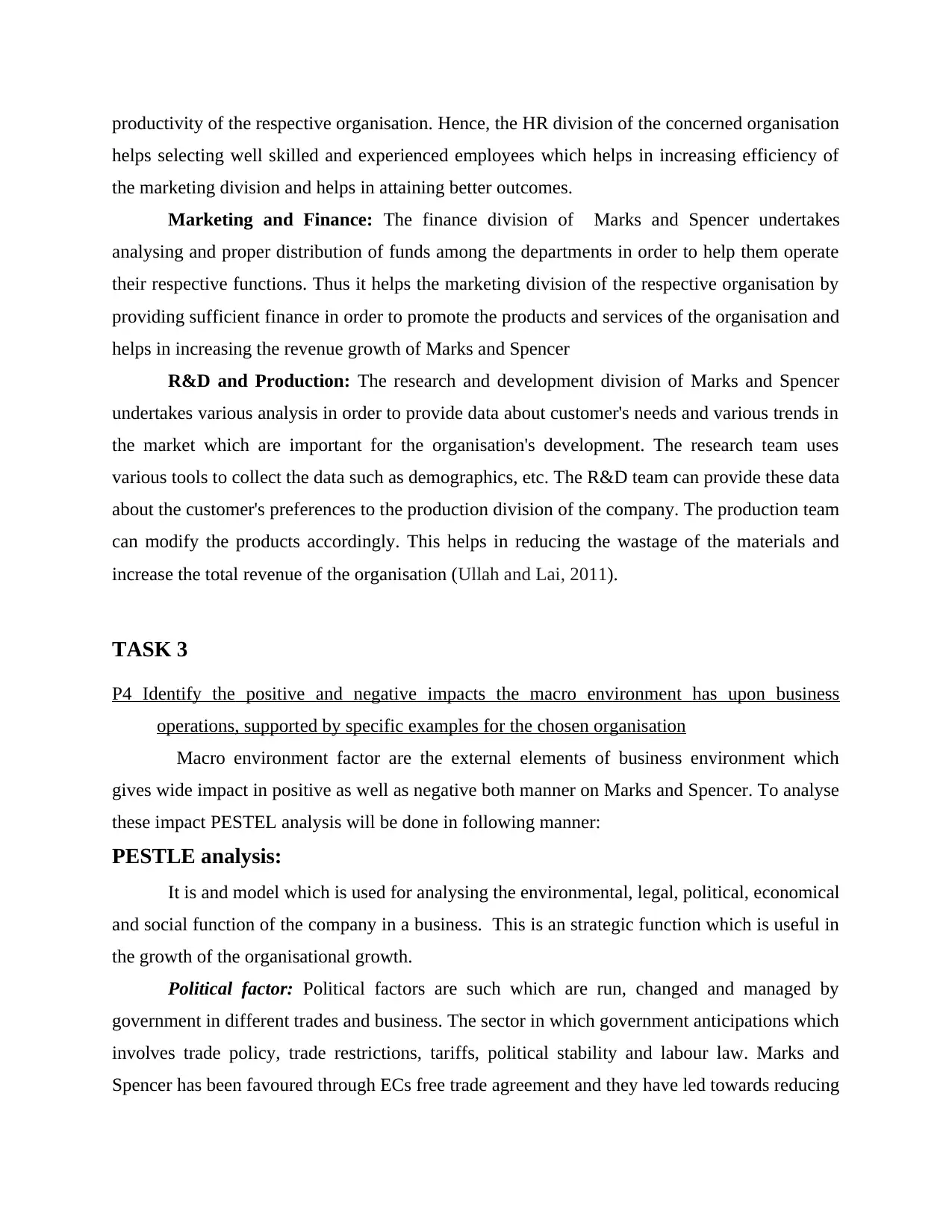
productivity of the respective organisation. Hence, the HR division of the concerned organisation
helps selecting well skilled and experienced employees which helps in increasing efficiency of
the marketing division and helps in attaining better outcomes.
Marketing and Finance: The finance division of Marks and Spencer undertakes
analysing and proper distribution of funds among the departments in order to help them operate
their respective functions. Thus it helps the marketing division of the respective organisation by
providing sufficient finance in order to promote the products and services of the organisation and
helps in increasing the revenue growth of Marks and Spencer
R&D and Production: The research and development division of Marks and Spencer
undertakes various analysis in order to provide data about customer's needs and various trends in
the market which are important for the organisation's development. The research team uses
various tools to collect the data such as demographics, etc. The R&D team can provide these data
about the customer's preferences to the production division of the company. The production team
can modify the products accordingly. This helps in reducing the wastage of the materials and
increase the total revenue of the organisation (Ullah and Lai, 2011).
TASK 3
P4 Identify the positive and negative impacts the macro environment has upon business
operations, supported by specific examples for the chosen organisation
Macro environment factor are the external elements of business environment which
gives wide impact in positive as well as negative both manner on Marks and Spencer. To analyse
these impact PESTEL analysis will be done in following manner:
PESTLE analysis:
It is and model which is used for analysing the environmental, legal, political, economical
and social function of the company in a business. This is an strategic function which is useful in
the growth of the organisational growth.
Political factor: Political factors are such which are run, changed and managed by
government in different trades and business. The sector in which government anticipations which
involves trade policy, trade restrictions, tariffs, political stability and labour law. Marks and
Spencer has been favoured through ECs free trade agreement and they have led towards reducing
helps selecting well skilled and experienced employees which helps in increasing efficiency of
the marketing division and helps in attaining better outcomes.
Marketing and Finance: The finance division of Marks and Spencer undertakes
analysing and proper distribution of funds among the departments in order to help them operate
their respective functions. Thus it helps the marketing division of the respective organisation by
providing sufficient finance in order to promote the products and services of the organisation and
helps in increasing the revenue growth of Marks and Spencer
R&D and Production: The research and development division of Marks and Spencer
undertakes various analysis in order to provide data about customer's needs and various trends in
the market which are important for the organisation's development. The research team uses
various tools to collect the data such as demographics, etc. The R&D team can provide these data
about the customer's preferences to the production division of the company. The production team
can modify the products accordingly. This helps in reducing the wastage of the materials and
increase the total revenue of the organisation (Ullah and Lai, 2011).
TASK 3
P4 Identify the positive and negative impacts the macro environment has upon business
operations, supported by specific examples for the chosen organisation
Macro environment factor are the external elements of business environment which
gives wide impact in positive as well as negative both manner on Marks and Spencer. To analyse
these impact PESTEL analysis will be done in following manner:
PESTLE analysis:
It is and model which is used for analysing the environmental, legal, political, economical
and social function of the company in a business. This is an strategic function which is useful in
the growth of the organisational growth.
Political factor: Political factors are such which are run, changed and managed by
government in different trades and business. The sector in which government anticipations which
involves trade policy, trade restrictions, tariffs, political stability and labour law. Marks and
Spencer has been favoured through ECs free trade agreement and they have led towards reducing
Paraphrase This Document
Need a fresh take? Get an instant paraphrase of this document with our AI Paraphraser
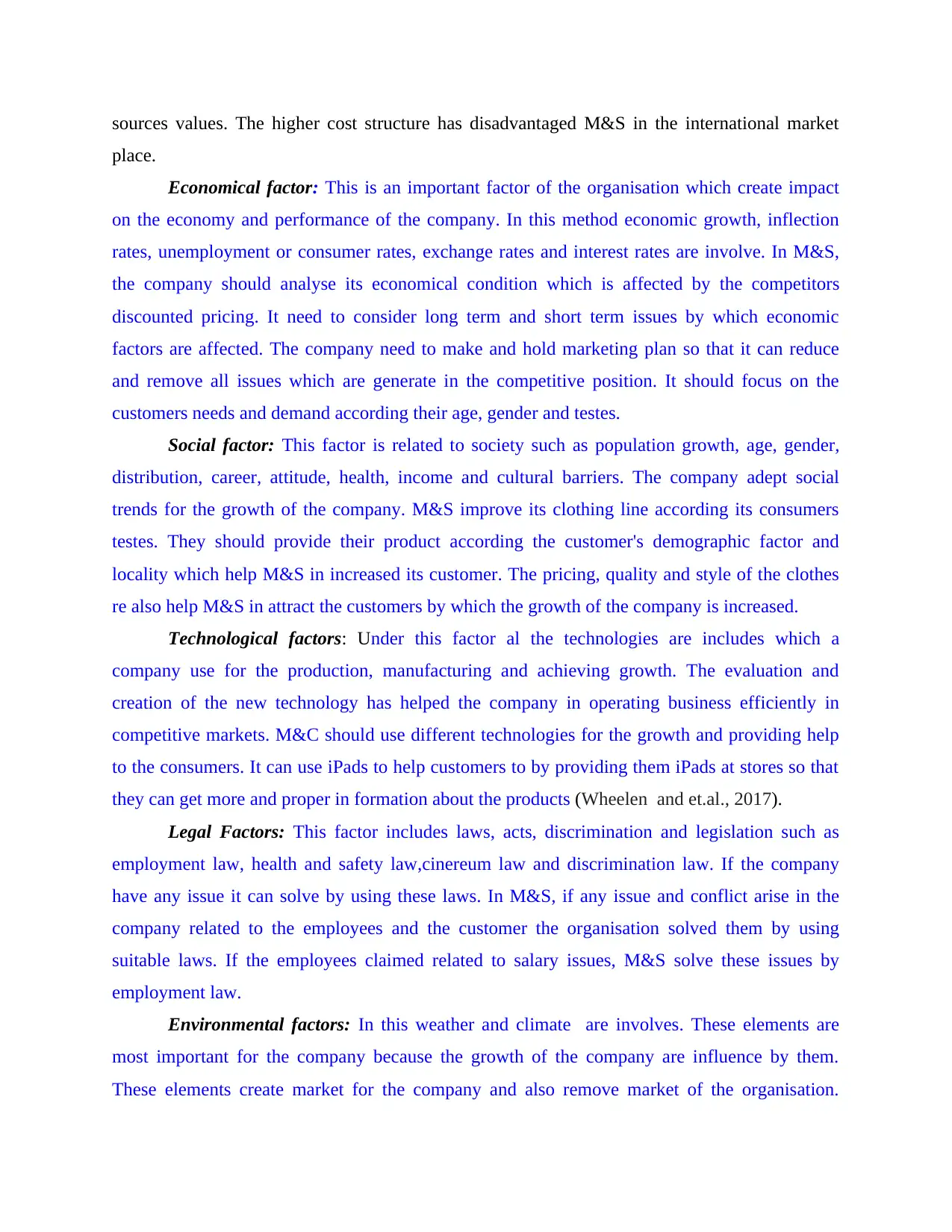
sources values. The higher cost structure has disadvantaged M&S in the international market
place.
Economical factor: This is an important factor of the organisation which create impact
on the economy and performance of the company. In this method economic growth, inflection
rates, unemployment or consumer rates, exchange rates and interest rates are involve. In M&S,
the company should analyse its economical condition which is affected by the competitors
discounted pricing. It need to consider long term and short term issues by which economic
factors are affected. The company need to make and hold marketing plan so that it can reduce
and remove all issues which are generate in the competitive position. It should focus on the
customers needs and demand according their age, gender and testes.
Social factor: This factor is related to society such as population growth, age, gender,
distribution, career, attitude, health, income and cultural barriers. The company adept social
trends for the growth of the company. M&S improve its clothing line according its consumers
testes. They should provide their product according the customer's demographic factor and
locality which help M&S in increased its customer. The pricing, quality and style of the clothes
re also help M&S in attract the customers by which the growth of the company is increased.
Technological factors: Under this factor al the technologies are includes which a
company use for the production, manufacturing and achieving growth. The evaluation and
creation of the new technology has helped the company in operating business efficiently in
competitive markets. M&C should use different technologies for the growth and providing help
to the consumers. It can use iPads to help customers to by providing them iPads at stores so that
they can get more and proper in formation about the products (Wheelen and et.al., 2017).
Legal Factors: This factor includes laws, acts, discrimination and legislation such as
employment law, health and safety law,cinereum law and discrimination law. If the company
have any issue it can solve by using these laws. In M&S, if any issue and conflict arise in the
company related to the employees and the customer the organisation solved them by using
suitable laws. If the employees claimed related to salary issues, M&S solve these issues by
employment law.
Environmental factors: In this weather and climate are involves. These elements are
most important for the company because the growth of the company are influence by them.
These elements create market for the company and also remove market of the organisation.
place.
Economical factor: This is an important factor of the organisation which create impact
on the economy and performance of the company. In this method economic growth, inflection
rates, unemployment or consumer rates, exchange rates and interest rates are involve. In M&S,
the company should analyse its economical condition which is affected by the competitors
discounted pricing. It need to consider long term and short term issues by which economic
factors are affected. The company need to make and hold marketing plan so that it can reduce
and remove all issues which are generate in the competitive position. It should focus on the
customers needs and demand according their age, gender and testes.
Social factor: This factor is related to society such as population growth, age, gender,
distribution, career, attitude, health, income and cultural barriers. The company adept social
trends for the growth of the company. M&S improve its clothing line according its consumers
testes. They should provide their product according the customer's demographic factor and
locality which help M&S in increased its customer. The pricing, quality and style of the clothes
re also help M&S in attract the customers by which the growth of the company is increased.
Technological factors: Under this factor al the technologies are includes which a
company use for the production, manufacturing and achieving growth. The evaluation and
creation of the new technology has helped the company in operating business efficiently in
competitive markets. M&C should use different technologies for the growth and providing help
to the consumers. It can use iPads to help customers to by providing them iPads at stores so that
they can get more and proper in formation about the products (Wheelen and et.al., 2017).
Legal Factors: This factor includes laws, acts, discrimination and legislation such as
employment law, health and safety law,cinereum law and discrimination law. If the company
have any issue it can solve by using these laws. In M&S, if any issue and conflict arise in the
company related to the employees and the customer the organisation solved them by using
suitable laws. If the employees claimed related to salary issues, M&S solve these issues by
employment law.
Environmental factors: In this weather and climate are involves. These elements are
most important for the company because the growth of the company are influence by them.
These elements create market for the company and also remove market of the organisation.
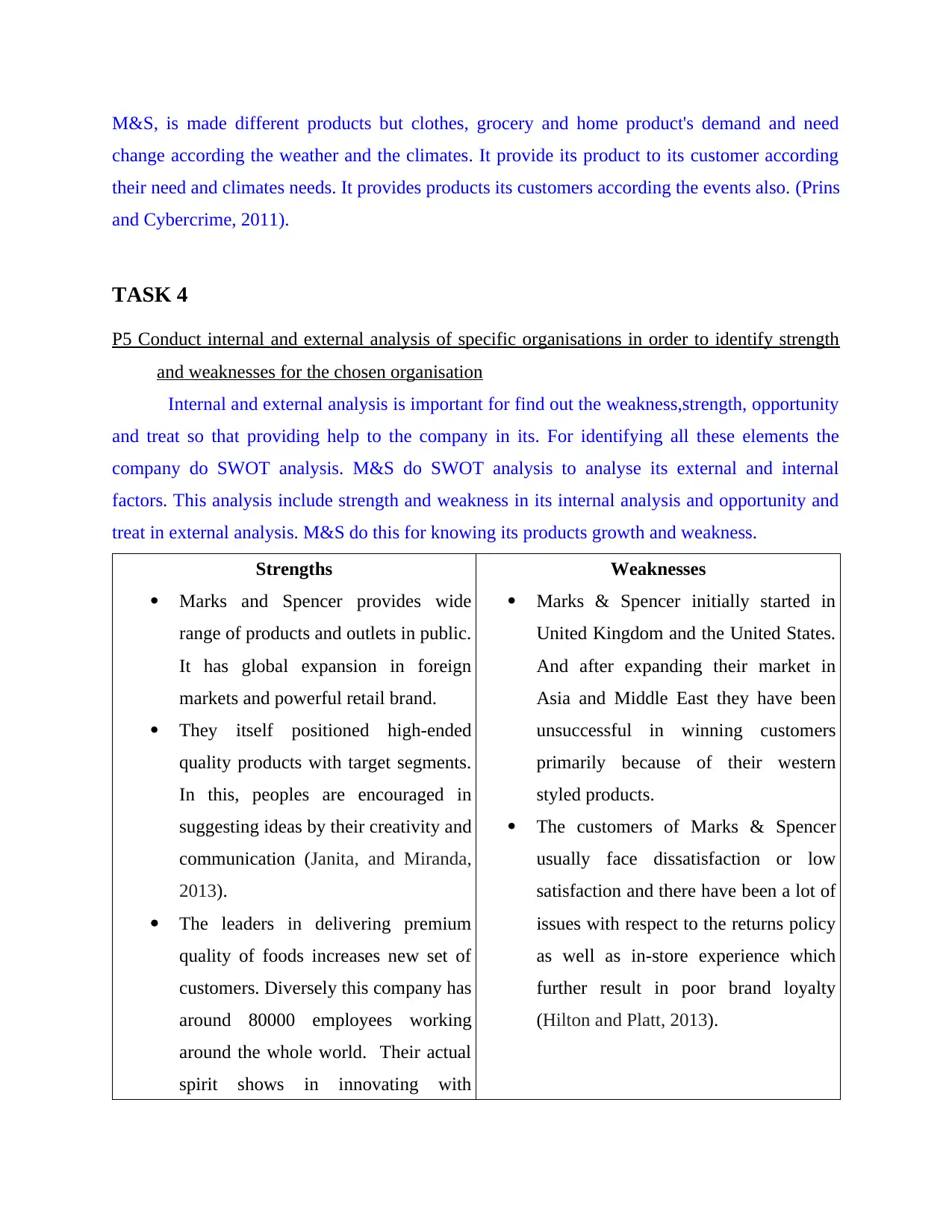
M&S, is made different products but clothes, grocery and home product's demand and need
change according the weather and the climates. It provide its product to its customer according
their need and climates needs. It provides products its customers according the events also. (Prins
and Cybercrime, 2011).
TASK 4
P5 Conduct internal and external analysis of specific organisations in order to identify strength
and weaknesses for the chosen organisation
Internal and external analysis is important for find out the weakness,strength, opportunity
and treat so that providing help to the company in its. For identifying all these elements the
company do SWOT analysis. M&S do SWOT analysis to analyse its external and internal
factors. This analysis include strength and weakness in its internal analysis and opportunity and
treat in external analysis. M&S do this for knowing its products growth and weakness.
Strengths
Marks and Spencer provides wide
range of products and outlets in public.
It has global expansion in foreign
markets and powerful retail brand.
They itself positioned high-ended
quality products with target segments.
In this, peoples are encouraged in
suggesting ideas by their creativity and
communication (Janita, and Miranda,
2013).
The leaders in delivering premium
quality of foods increases new set of
customers. Diversely this company has
around 80000 employees working
around the whole world. Their actual
spirit shows in innovating with
Weaknesses
Marks & Spencer initially started in
United Kingdom and the United States.
And after expanding their market in
Asia and Middle East they have been
unsuccessful in winning customers
primarily because of their western
styled products.
The customers of Marks & Spencer
usually face dissatisfaction or low
satisfaction and there have been a lot of
issues with respect to the returns policy
as well as in-store experience which
further result in poor brand loyalty
(Hilton and Platt, 2013).
change according the weather and the climates. It provide its product to its customer according
their need and climates needs. It provides products its customers according the events also. (Prins
and Cybercrime, 2011).
TASK 4
P5 Conduct internal and external analysis of specific organisations in order to identify strength
and weaknesses for the chosen organisation
Internal and external analysis is important for find out the weakness,strength, opportunity
and treat so that providing help to the company in its. For identifying all these elements the
company do SWOT analysis. M&S do SWOT analysis to analyse its external and internal
factors. This analysis include strength and weakness in its internal analysis and opportunity and
treat in external analysis. M&S do this for knowing its products growth and weakness.
Strengths
Marks and Spencer provides wide
range of products and outlets in public.
It has global expansion in foreign
markets and powerful retail brand.
They itself positioned high-ended
quality products with target segments.
In this, peoples are encouraged in
suggesting ideas by their creativity and
communication (Janita, and Miranda,
2013).
The leaders in delivering premium
quality of foods increases new set of
customers. Diversely this company has
around 80000 employees working
around the whole world. Their actual
spirit shows in innovating with
Weaknesses
Marks & Spencer initially started in
United Kingdom and the United States.
And after expanding their market in
Asia and Middle East they have been
unsuccessful in winning customers
primarily because of their western
styled products.
The customers of Marks & Spencer
usually face dissatisfaction or low
satisfaction and there have been a lot of
issues with respect to the returns policy
as well as in-store experience which
further result in poor brand loyalty
(Hilton and Platt, 2013).
⊘ This is a preview!⊘
Do you want full access?
Subscribe today to unlock all pages.

Trusted by 1+ million students worldwide
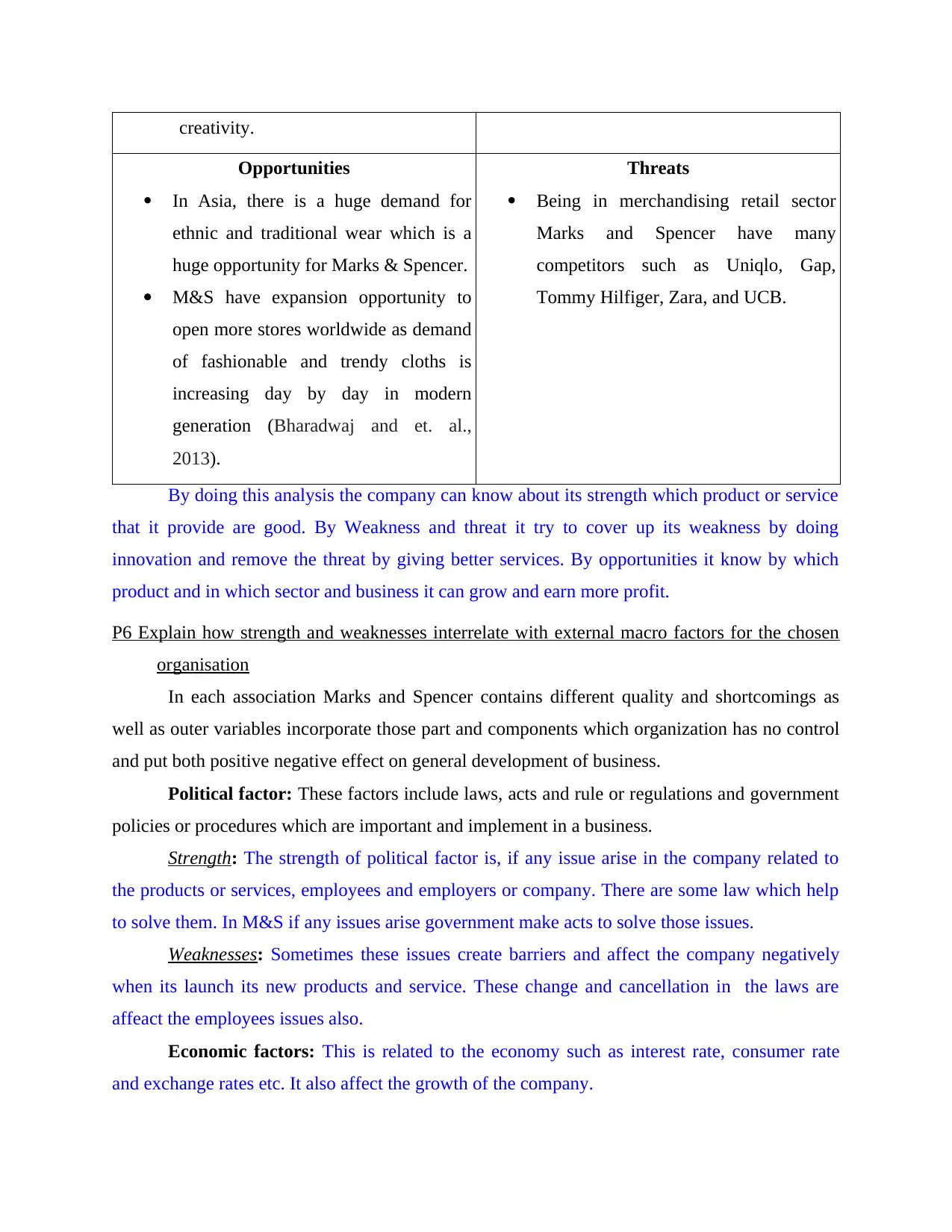
creativity.
Opportunities
In Asia, there is a huge demand for
ethnic and traditional wear which is a
huge opportunity for Marks & Spencer.
M&S have expansion opportunity to
open more stores worldwide as demand
of fashionable and trendy cloths is
increasing day by day in modern
generation (Bharadwaj and et. al.,
2013).
Threats
Being in merchandising retail sector
Marks and Spencer have many
competitors such as Uniqlo, Gap,
Tommy Hilfiger, Zara, and UCB.
By doing this analysis the company can know about its strength which product or service
that it provide are good. By Weakness and threat it try to cover up its weakness by doing
innovation and remove the threat by giving better services. By opportunities it know by which
product and in which sector and business it can grow and earn more profit.
P6 Explain how strength and weaknesses interrelate with external macro factors for the chosen
organisation
In each association Marks and Spencer contains different quality and shortcomings as
well as outer variables incorporate those part and components which organization has no control
and put both positive negative effect on general development of business.
Political factor: These factors include laws, acts and rule or regulations and government
policies or procedures which are important and implement in a business.
Strength: The strength of political factor is, if any issue arise in the company related to
the products or services, employees and employers or company. There are some law which help
to solve them. In M&S if any issues arise government make acts to solve those issues.
Weaknesses: Sometimes these issues create barriers and affect the company negatively
when its launch its new products and service. These change and cancellation in the laws are
affeact the employees issues also.
Economic factors: This is related to the economy such as interest rate, consumer rate
and exchange rates etc. It also affect the growth of the company.
Opportunities
In Asia, there is a huge demand for
ethnic and traditional wear which is a
huge opportunity for Marks & Spencer.
M&S have expansion opportunity to
open more stores worldwide as demand
of fashionable and trendy cloths is
increasing day by day in modern
generation (Bharadwaj and et. al.,
2013).
Threats
Being in merchandising retail sector
Marks and Spencer have many
competitors such as Uniqlo, Gap,
Tommy Hilfiger, Zara, and UCB.
By doing this analysis the company can know about its strength which product or service
that it provide are good. By Weakness and threat it try to cover up its weakness by doing
innovation and remove the threat by giving better services. By opportunities it know by which
product and in which sector and business it can grow and earn more profit.
P6 Explain how strength and weaknesses interrelate with external macro factors for the chosen
organisation
In each association Marks and Spencer contains different quality and shortcomings as
well as outer variables incorporate those part and components which organization has no control
and put both positive negative effect on general development of business.
Political factor: These factors include laws, acts and rule or regulations and government
policies or procedures which are important and implement in a business.
Strength: The strength of political factor is, if any issue arise in the company related to
the products or services, employees and employers or company. There are some law which help
to solve them. In M&S if any issues arise government make acts to solve those issues.
Weaknesses: Sometimes these issues create barriers and affect the company negatively
when its launch its new products and service. These change and cancellation in the laws are
affeact the employees issues also.
Economic factors: This is related to the economy such as interest rate, consumer rate
and exchange rates etc. It also affect the growth of the company.
Paraphrase This Document
Need a fresh take? Get an instant paraphrase of this document with our AI Paraphraser
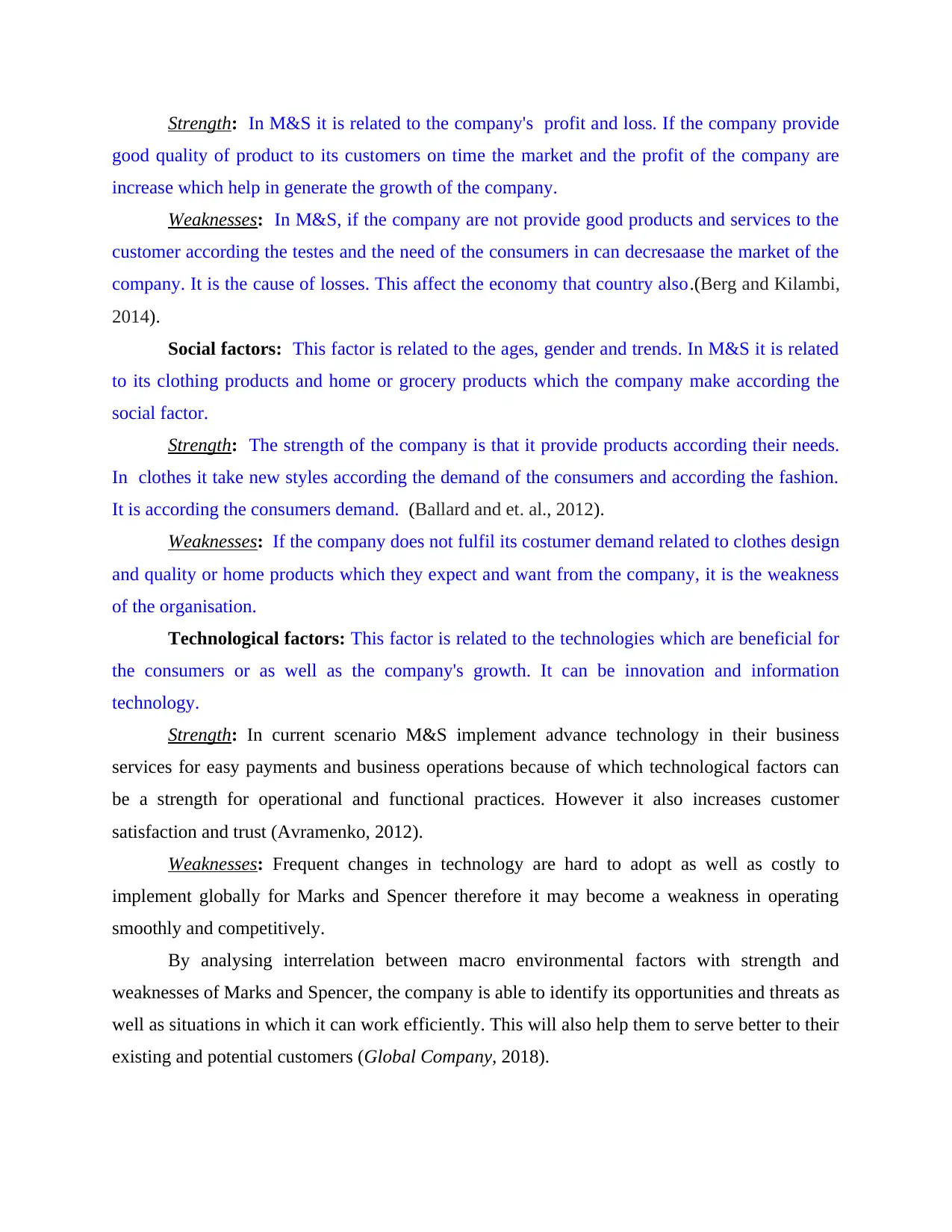
Strength: In M&S it is related to the company's profit and loss. If the company provide
good quality of product to its customers on time the market and the profit of the company are
increase which help in generate the growth of the company.
Weaknesses: In M&S, if the company are not provide good products and services to the
customer according the testes and the need of the consumers in can decresaase the market of the
company. It is the cause of losses. This affect the economy that country also.(Berg and Kilambi,
2014).
Social factors: This factor is related to the ages, gender and trends. In M&S it is related
to its clothing products and home or grocery products which the company make according the
social factor.
Strength: The strength of the company is that it provide products according their needs.
In clothes it take new styles according the demand of the consumers and according the fashion.
It is according the consumers demand. (Ballard and et. al., 2012).
Weaknesses: If the company does not fulfil its costumer demand related to clothes design
and quality or home products which they expect and want from the company, it is the weakness
of the organisation.
Technological factors: This factor is related to the technologies which are beneficial for
the consumers or as well as the company's growth. It can be innovation and information
technology.
Strength: In current scenario M&S implement advance technology in their business
services for easy payments and business operations because of which technological factors can
be a strength for operational and functional practices. However it also increases customer
satisfaction and trust (Avramenko, 2012).
Weaknesses: Frequent changes in technology are hard to adopt as well as costly to
implement globally for Marks and Spencer therefore it may become a weakness in operating
smoothly and competitively.
By analysing interrelation between macro environmental factors with strength and
weaknesses of Marks and Spencer, the company is able to identify its opportunities and threats as
well as situations in which it can work efficiently. This will also help them to serve better to their
existing and potential customers (Global Company, 2018).
good quality of product to its customers on time the market and the profit of the company are
increase which help in generate the growth of the company.
Weaknesses: In M&S, if the company are not provide good products and services to the
customer according the testes and the need of the consumers in can decresaase the market of the
company. It is the cause of losses. This affect the economy that country also.(Berg and Kilambi,
2014).
Social factors: This factor is related to the ages, gender and trends. In M&S it is related
to its clothing products and home or grocery products which the company make according the
social factor.
Strength: The strength of the company is that it provide products according their needs.
In clothes it take new styles according the demand of the consumers and according the fashion.
It is according the consumers demand. (Ballard and et. al., 2012).
Weaknesses: If the company does not fulfil its costumer demand related to clothes design
and quality or home products which they expect and want from the company, it is the weakness
of the organisation.
Technological factors: This factor is related to the technologies which are beneficial for
the consumers or as well as the company's growth. It can be innovation and information
technology.
Strength: In current scenario M&S implement advance technology in their business
services for easy payments and business operations because of which technological factors can
be a strength for operational and functional practices. However it also increases customer
satisfaction and trust (Avramenko, 2012).
Weaknesses: Frequent changes in technology are hard to adopt as well as costly to
implement globally for Marks and Spencer therefore it may become a weakness in operating
smoothly and competitively.
By analysing interrelation between macro environmental factors with strength and
weaknesses of Marks and Spencer, the company is able to identify its opportunities and threats as
well as situations in which it can work efficiently. This will also help them to serve better to their
existing and potential customers (Global Company, 2018).
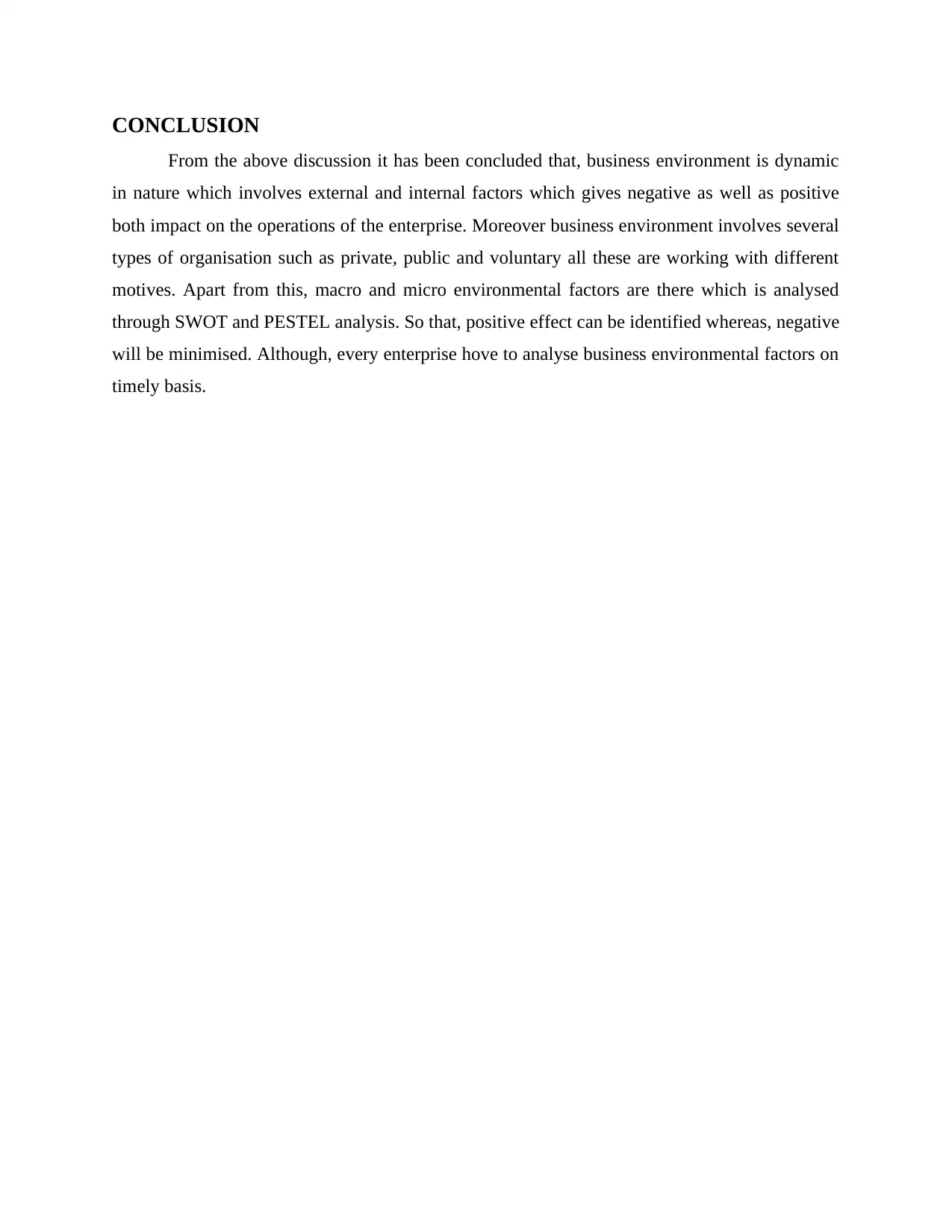
CONCLUSION
From the above discussion it has been concluded that, business environment is dynamic
in nature which involves external and internal factors which gives negative as well as positive
both impact on the operations of the enterprise. Moreover business environment involves several
types of organisation such as private, public and voluntary all these are working with different
motives. Apart from this, macro and micro environmental factors are there which is analysed
through SWOT and PESTEL analysis. So that, positive effect can be identified whereas, negative
will be minimised. Although, every enterprise hove to analyse business environmental factors on
timely basis.
From the above discussion it has been concluded that, business environment is dynamic
in nature which involves external and internal factors which gives negative as well as positive
both impact on the operations of the enterprise. Moreover business environment involves several
types of organisation such as private, public and voluntary all these are working with different
motives. Apart from this, macro and micro environmental factors are there which is analysed
through SWOT and PESTEL analysis. So that, positive effect can be identified whereas, negative
will be minimised. Although, every enterprise hove to analyse business environmental factors on
timely basis.
⊘ This is a preview!⊘
Do you want full access?
Subscribe today to unlock all pages.

Trusted by 1+ million students worldwide
1 out of 13
Related Documents
Your All-in-One AI-Powered Toolkit for Academic Success.
+13062052269
info@desklib.com
Available 24*7 on WhatsApp / Email
![[object Object]](/_next/static/media/star-bottom.7253800d.svg)
Unlock your academic potential
Copyright © 2020–2025 A2Z Services. All Rights Reserved. Developed and managed by ZUCOL.




